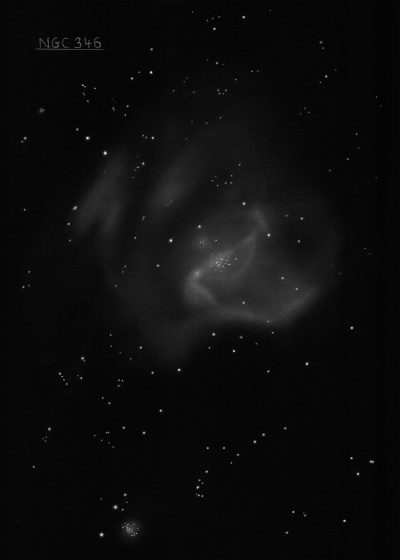
Without the filter, the nebula is set in a rich star field (Hodge Association 45) and a number of stars are superimposed or involved with the nebula, some in the center. NGC 346 hosts 33 O-type stars, several in a small clump including a massive 02-type mag 12.8 star and a mag 12.6 O4-type star. On the NE side is HD 5980, an ultra-luminous mag 11.3 Wolf-Rayet binary (WN4+O7), one of the brightest stars in the SMC. The surrounding region is rich in fainter stars.
NGC 371 is in same low power field 22' NE and NGC 330 lies 21' SW. The small clusters NGC 306 and 299 lies 22' WSW and 26' W, respectively.
10x30mm and 15x50mm: NGC 346 is easily visible in binoculars.
James Dunlop discovered NGC 346 = D 25 on 1 Aug 1826 with his 9" speculum reflector and recorded a "pretty large, pretty bright nebula, about 2.25' diameter, irregular round figure, resolvable, very slight condensation, not well defined at the edges. He observed it on 7 occasions and his position is unusually accurate.
John Herschel gives 5 descriptions in his Cape observations: He first observed it on 11 Apr 1834 as "B, L, pmE, pgmbM, 5', resolvable (ill seen, below the pole)." On a second sweep he called it "Cluster, imperfectly resolved; rather irregular figure; 5' diameter. Not equally condensed about centre; fades imperceptibly; has a double star (12th mag) in centre." His third observation was recorded as "B, L, irregularly round, gmbM, 3' or 4' in extent, fades away insensibly." His next sweep was recorded as "B, L, neb with resolvable centre; irregularly extended into a kind of broad train as in figure, gently graduating away to the borders. 6' diameter." His final observation was logged as "B, L, irregular figure, with a star 13th mag in most compressed part." His published sketch is in the CGH catalogue on plate IV, figure 6.
Joseph Turner sketched NGC 346 with the 48" Great Melbourne Telescope on 17 Dec 1875, with an "arm" attached on the NW end of bar, hooking to the east. It also shows a very small knot of stars about 0.8' NE of center (plate I, figure 4 "Observations of Southern Nebulae made with the Great Melbourne Telescope 1869 - 1885"). He commented, "It is very unlike H.'s drawing and description; indeed I cannot trace any resemblance between that and its present appearance; and were it not for its position, and the fact that L.S. observed and sketched it on 5th February 1870, I should be in great doubt as to its being the proper object. The position, however, accords with that given by Herschel, and Le Sueur's sketch [plate VII, figure 79] is, in its general features, very like mine, so that there is no room for doubting its identity. The central portion is by far the brightest, being a cluster of stars so very distinct that they could almost be counted; and the nebula here also appears the most dense. From this point it proceeds s.f. for almost 1' 30", terminating in a few very faint stars. Towards the n.p. direction it forms a complete bend or hook, and is here very faint. A little n.f. the main or central portion is a very small and faint round patch, which at times looks like a cluster of very faint stars, but I cannot with certainty determine whether or not it be stars or only nebula, although the night is an exquisite one, being clear and steady."
Although a spectrum taken in 1919 at the Cordoba Observatory of Argentina clearly revealed a gaseous spectrum, Charles Perrine declared "the first true spiral which I have encountered that appears appears to consist almost wholly of gaseous nebulosity." (confusing the spiral morphology with a spiral galaxy).
400/500mm - 18" (7/6/02 - Magellan Observatory, Australia): this is the largest HII region in the SMC and an amazing sight at 171x using a UHC filter. The brightest section is a "bar" extending NW-SE with a well-defined edge along the northern side. Extending from the central region are two sweeping "arms" or extensions, creating an exaggerated "S" appearance similar to a barred spiral galaxy! The longer but lower surface brightness arm is attached at the southeast end of the central region and broadly sweeps towards the west, below the bar. The shorter, but high surface brightness arm is attached at the northwest end and hooks towards the east. These extensions increase the diameter to 8'-10' in total size!
Notes by Steve Gottlieb